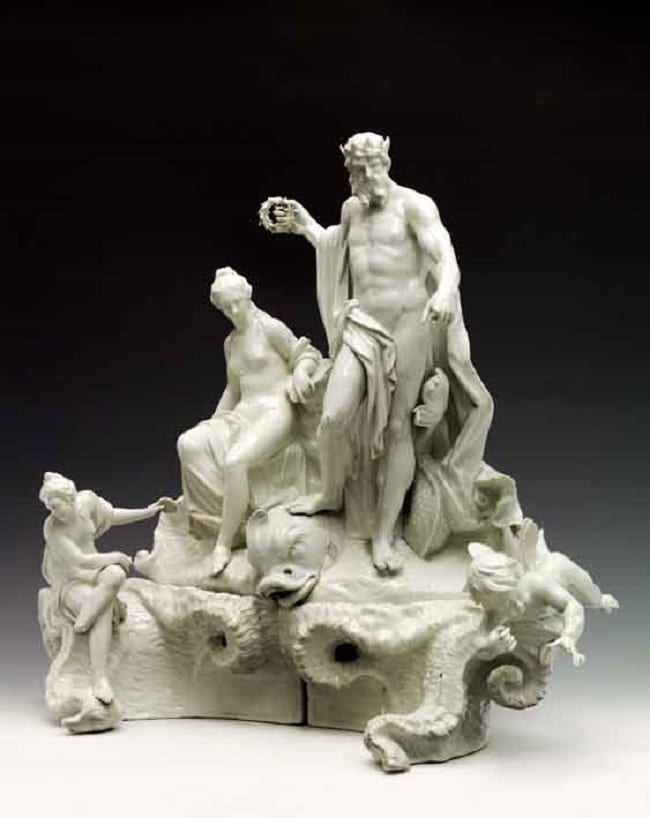This porcelain water fountain for the table from Meissen was described by the British Ambassador in Dresden at the time, Sir Charles Hanbury Williams, in a dispatch from 1748:
“I was once at a dinner where we sat down at one table two hundred and six people… When the dessert was set on, I thought it was the most wonderful thing I ever beheld. I fancyd myself either in a garden or at the opera. But I [could] not imagine that I was at dinner. In the middle of the table was [a] fountain … , which ran all the while with rose-water, and ‘tis said that this piece alone cost six thousand thalers.”
For the first time in 150 years it will go on public display when the Victoria & Albert Museum’s new Europe 1600-1800 galleries open in late 2014. The theatrical dining decoration came into the Museum’s collection as part of a large group of white porcelain parts. There were more than 150 fragments spread across four cabinets, some of which may not have been from the fountain in question. However, the Museum’s re-examination of the collection in preparation for the new galleries and a partnership with the Royal College of Art touched off an ambitious 18-month project to restore the fountain. Advanced 3D modeling and printing techniques were used alongside traditional craftsmanship and conservation to reconstruct the fountain, which helps bring alive the fine dining and entertainment traditions of Europe’s most splendid courts.
The fountain – nearly four meters long – was commissioned by one of the most extravagant characters of the age, Heinrich, Count von Brühl, Prime Minister at the Saxon court in Dresden. It depicts Neptune and Amphritrite being drawn on a shell-chariot by hippocamps and was ordered as a scale model of a stone fountain built in the gardens of von Brühl’s summer palace in Dresden. An early example of the fine white porcelain of the Meissen factory, the fully operational model would have been used to entertain guests at sumptuous dinner parties and state events. As we can see from the ambassador’s early quote, the fountain would have been unveiled during dessert, running with fragrant rosewater.
When the Museum acquired the fountain, many of the parts were broken or missing, with the official description reading “much shattered.” After careful sorting, it was clear that some parts were originals made between 1745 and 1747, some were missing, some were duplicates or later replacements and many did not belong to the fountain at all.
Reino Liefkes, Senior Curator said that the Museum’s piece was believed to be a later version of the so-called “lost fountain,” but upon further examination it was determined the Museum had the original along with a number of replacement parts.
In order to achieve historic accuracy, scanning technology was used to construct accurate 3D models of the missing parts. “Real” models were then created by machine milling or, for the finer pieces requiring greater detail, printed in resin using 3D printers at J.H. May Ltd. in Essex. Multi-part plaster molds were taken from the models by B&C Mouldmakers, a traditional firm in Staffordshire.
Steve Brown, a ceramic artist working at the Royal College of Art in London, is using these to create the missing parts by pressing the clay into the part-molds. He assembles these and adds fine detail such as leaf and shell work, just as the modellers in Meissen would have done more than 150 years ago.
After a lengthy drying process the final pieces are fired, glazed and fired again at the RCA. Each model was enlarged to 115% of the size of the original pieces to account for shrinkage during drying and firing. Brown made at least 50 different trial pieces to establish the combination of porcelain and glaze that would match the appearance of the original fountain parts.
The Museum also re-created some parts for which there were no parallels. Of the four sections of curved, sloping walls, that flank the fountain on either side, only the two on the right have survived, albeit broken in various pieces. After they were restored, these were scanned to create 3D copies, digitally-flipped to create accurate models for the two sections of wall on the left.
The final reconstruction will bring together the original parts made for Von Brühl, with those made later and the replacement parts created at the RCA. Existing parts of the fountain have been cleaned, bonded together and missing areas have been filled and retouched by paintbrush with care taken to match the irregularities of the original glazed surface.
Above image: The much-storied, much-abused Meissen fountain of Count von Brühl of Dresden. The Victoria and Albert Museum is undertaking a lengthy process to reconstruct the broken fountain, employing 3D modeling technology and traditional ceramic craftsmanship.
Visit the Victoria and Albert Museum

hello there and thank you for your info – I’ve certainly
picked up something new from right here. I did however expertise a few technical points using this
website, since I experienced to reload the website a lot of times previous to I could get it to
load properly. I had been wondering if your web hosting
is OK? Not that I’m complaining, but sluggish loading instances times will
very frequently affect your placement in google and can damage your
high-quality score if ads and marketing with Adwords.
Well I am adding this RSS to my email and can look out for
a lot more of your respective fascinating content.
Make sure you update this again soon.